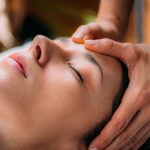Michael Kern, together with Franklyn Sills, founded the Craniosacral Therapy Educational Trust (CTET) in 1989 as a teaching facility for Craniosacral Therapy, offering in-depth courses in London for aspiring practitioners. Michael Kern came from a background in osteopathy and is author of ‘Wisdom In The Body: The Craniosacral Approach To Essential Health’, while Franklyn Sills has been a pioneering teacher in this field and has published several books on Craniosacral Biodynamics.
The Trust has been an important school in the development of Biodynamic Craniosacral Therapy, in which the practitioner’s orientation is to work with the underlying forces that govern how we function.
Breath of Life
The ‘breath of life’ has been described as an underlying organising force that manifests in the expression of rhythmic motions in the body. At least three subtle rhythms have been identified each of which has its own rates and functions.
The cranial rhythmic impulse (CRI) is the most superficial rhythm within this system, and averages eight to 12 cycles each minute. It’s expressed as a subtle rocking of the tissues and fluids in the body as they respond to deeper forces and prevailing conditions. The mid-tide is a deeper and slower rhythm that expresses at around two and a half cycles each minute and may be experienced as a subtle inner breathing of all tissues and cells. The long tide is an even deeper rhythm, completing a single cycle approximately once every 100 seconds. In Biodynamic Craniosacral Therapy the long tide is considered to be responsible for carrying an ordering matrix into the body, promoting maintenance, healing and re-generation, and fundamentally orchestrating the body to restore balance and health.
Internal Intelligence
The body contains a profound wisdom that knows exactly how to heal, given the right conditions. Biodynamic Craniosacral Therapists learn how to trust and create space for this intelligence to manifest, supporting the conditions for deep healing to manifest. The practitioners’ development of a perceptual relationship to these underlying forces of health is key in the evaluation, diagnosis and treatment of clients. This is not an intellectual process of evaluation used in many other medical and therapeutic modalities, but a direct sensory experience. By orienting to and sensing the rhythms of the body and the deeper stillness within, Biodynamic Craniosacral Therapists can identify the body’s own priorities of treatment and support our extensive healing capacities
Whole Person Approach
A whole person approach to treatment is taught at CTET and students are supported to learn to synchronise with the underlying forces that govern our health. This involves acknowledging the interconnections between body, mind and spirit, and how the different parts of ourselves function in a dynamic and balanced relationship and inter-connection. Successful graduates on the training receive professional Craniosacral Therapy diplomas and eligibility to join numerous professional associations in the UK and around the world.






